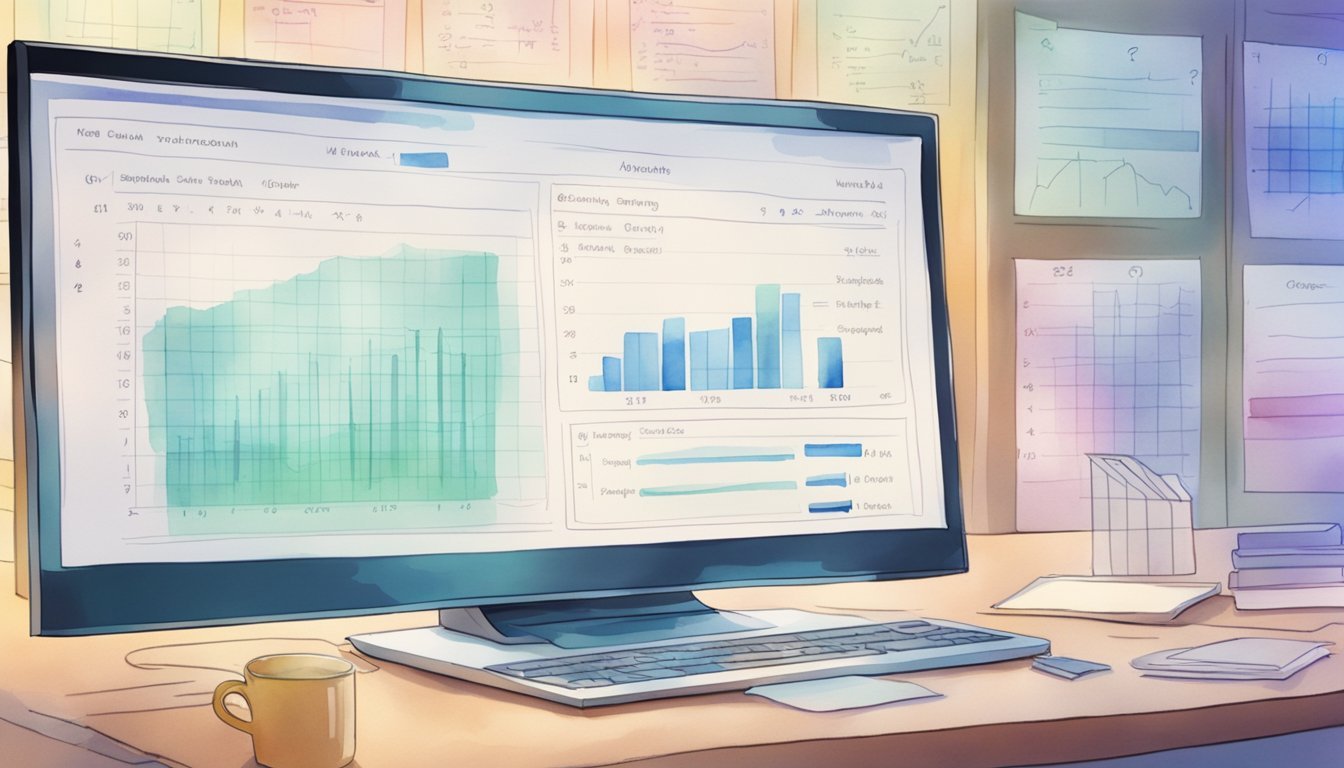Freelance Data Analysis: The Ultimate Side Hustle Guide

Freelance data analysis is a great side hustle that offers flexibility and the chance to work with diverse clients.
Whether you’re just starting or have years of experience, there are many opportunities available.
This field allows you to dive into various projects, from understanding complex datasets to helping businesses make data-driven decisions. You’ll find it’s a rewarding way to utilize your analytical skills while earning extra income.

Working as a freelance data analyst can be especially appealing if you value independence and control over your work schedule.
Platforms like Upwork and Toptal feature numerous remote data analyst positions, connecting you to global clients, including Fortune 500 companies and exciting startups.
This career path not only boosts your resume but also enhances your proficiency with the latest data analysis tools.
Getting started might seem challenging, but the rewards are substantial.
You’ll need to market your skills effectively, set competitive pricing, and stay updated on best practices in data analysis.
Being able to quickly transform raw data into actionable insights is crucial for success in this field.
As you build a reputation, you can expand your client base and increase your rates, making freelance data analysis a lucrative avenue.
Key Takeaways
- Freelance data analysis is a flexible and rewarding side hustle.
- Platforms like Upwork and Toptal offer many remote opportunities.
- Marketing your skills and staying updated are crucial for success.
Understanding Freelance Data Analysis
Freelance data analysis offers flexible work opportunities for those skilled in data interpretation.
This section breaks down what a freelance data analyst does, the key skills and tools required, and how freelancing compares to full-time positions.
What Is a Freelance Data Analyst?
A freelance data analyst works independently, offering data analysis services to various clients.
Instead of being tied to one company, you can choose projects that interest you.
Most of your work involves collecting, analyzing, and interpreting data to help clients make informed decisions.
You might work on short-term projects, analyzing sales trends, customer behavior, or market research.
Freelancing allows you to set your own hours and rates, giving you more control over your work-life balance.
Skills and Tools for Data Analysis
To succeed as a freelance data analyst, you need strong analytical skills and proficiency in several tools and programming languages.
Key Skills:
- Problem-solving
- Statistical analysis
- Critical thinking
Essential Tools:
- Python: Widely used for data manipulation and analysis
- R: Helpful for statistical computing and graphics
- SQL: Used for managing and querying databases
Learning these tools improves your ability to deliver accurate and insightful data analysis, making you more attractive to potential clients.
Comparing Freelancers and Full-Time Data Analysts
There are distinct differences between freelance data analysts and full-time data analysts.
Freelancers:
- Flexibility in schedules
- Varied projects
- Control over workload
- Require strong self-marketing skills to find clients
Full-Time Employees:
- Steady income
- Job security
- Consistent work environment
- Regular access to company resources and benefits
While freelancing offers more freedom, it also demands greater self-discipline and business savvy.
Whether you choose freelancing or full-time work depends on your personal preferences and career goals.
Getting Started in Freelance Data Analysis
Beginning your journey as a freelance data analyst requires a few key steps: solidifying your skills, creating an appealing profile, and getting your services noticed.
This guide helps you build from the ground up and sets a clear path to establish yourself in the field.
Building a Strong Foundation
To excel as a freelance data analyst, you need a strong foundation in data analysis tools and techniques.
Master essential skills like Python, R, SQL, and Excel.
These four are the core languages and tools for analyzing and interpreting data.
Consider taking online courses or bootcamps to strengthen your skills.
Coursera, Udemy, and other platforms offer targeted learning paths.
A course in business management can also be valuable since freelancing means you are running your own business.
Practical experience is just as important.
Work on personal projects or participate in hackathons to practice your abilities.
Creating a portfolio showcasing these projects can demonstrate your expertise to potential clients.
Crafting Your Freelance Profile
Your freelance profile should reflect your skills, experience, and unique selling points.
Platforms like Upwork, Toptal, and LinkedIn are great places to start.
Take the time to fill out your profile thoroughly.
List technical skills such as Python, SQL, and Excel.
Add a brief bio that highlights your strengths and experience.
Including a professional photo and a portfolio of past projects can make your profile more appealing.
Ask for endorsements or testimonials from previous employers or colleagues.
Positive feedback adds credibility and can make you stand out.
Make sure your profile is regularly updated to reflect new skills and accomplishments.
Marketing Your Data Analysis Services
Marketing is crucial to attract clients.
Start by identifying your target audience and understanding their needs.
Use keywords related to data analysis to make your services easily discoverable.
Leverage social media platforms to promote your work.
Share insights on LinkedIn, Twitter, and relevant forums where potential clients might be active.
Creating content like blog posts or tutorials can showcase your expertise.
Networking is also important.
Attend industry events, webinars, and online communities.
Building relationships can lead to referrals and collaborations.
Offer a competitive rate initially to build a client base, then gradually increase your prices as you gain more experience and confidence.
By following these steps, you can establish a strong presence and succeed as a freelance data analyst.
Data Analysis Techniques and Best Practices

As a freelance data analyst, mastering statistical analysis, machine learning, data visualization, and dashboard creation is crucial to delivering valuable insights to your clients.
These techniques help you analyze complex datasets and present your findings clearly.
Statistical Analysis and Machine Learning
Statistical analysis involves applying mathematical theories to data to identify patterns and relationships.
Common techniques include regression analysis and hypothesis testing.
You use these methods to predict trends, inform decision-making, and provide insights.
Machine Learning (ML) builds on statistics by using algorithms to enable computers to learn from data without explicit programming.
Familiar tools include Python and R.
Techniques like classification and clustering allow you to handle large datasets effectively.
Proficiency in ML enhances your ability to deliver more accurate and meaningful analyses to your clients.
Data Visualization and Dashboard Creation
Data visualization is essential for transforming raw data into understandable formats.
Tools like Tableau and Power BI are popular for creating interactive charts and graphs.
You use these tools to highlight important insights and make data accessible.
Dashboards compile multiple visualizations into a single platform, making it easier to monitor KPIs and trends.
With a well-designed dashboard, your clients can view and interact with their data in real-time.
This skill is vital for freelance data analysts, as it adds value to your services and helps you communicate results effectively.
Technological Proficiency
To succeed in freelance data analysis, you need to master various technologies.
Your proficiency with programming languages, data tools, and big data processing is essential.
These skills not only make your work more efficient but also more appealing to potential clients.
Programming Languages and Data Tools
You need to know several programming languages to analyze data effectively. Python is very popular because it has many libraries like Pandas and NumPy, which are great for data manipulation and analysis. R is another important language, especially for statistical analysis and data visualization.
Excel is still widely used for data analysis, especially for small to medium-sized projects.
Knowing how to use Excel efficiently can help you quickly organize and interpret data.
SQL is crucial for working with databases.
It allows you to extract and manage large datasets.
Being comfortable with these tools will make your side hustle as a freelance data analyst much smoother.
Big Data and Data Processing
Big data involves handling massive amounts of data that traditional tools can’t manage.
You need to be familiar with technologies like Hadoop and Spark to process big data.
These tools help you break down huge datasets into manageable pieces.
Hadoop is used for distributed storage and processing of large datasets. Spark is faster and can handle real-time data processing, which is essential for timely insights.
Knowing about cloud services like AWS or Google Cloud can also be beneficial.
These platforms offer scalable storage and computing power, which are crucial for big data projects.
Being able to process big data efficiently can significantly enhance your freelance data analysis capabilities.
Becoming Industry Savvy
When doing freelance data analysis as a side hustle, it’s crucial to adapt to different industries and stay connected with current trends.
This will help you remain competitive and ensure your work is always relevant.
Adapting to Different Industries
As a freelancer, you’ll work with clients from various industries.
Each industry has unique data needs and practices.
For example, healthcare analysis requires understanding patient data and regulations, while financial analysis involves working with market trends and investment data.
You must tailor your approach and skills to match the specific requirements of each industry.
Take time to learn industry-specific software and tools.
For instance, knowing about SQL and Excel can be beneficial across many sectors.
Additionally, understanding the challenges faced by different industries can help you offer better services.
For example, the business side of things in various fields might impact how you present your analysis.
Networking and Industry Trends
Staying updated with industry trends is vital for your freelance success.
Networking plays a big part in this.
Join industry groups and attend conferences.
This will help you connect with potential clients and stay informed about new developments.
Use platforms like LinkedIn and other professional networks.
Regularly participate in discussions and share your insights.
This establishes you as an expert and attracts more clients.
Following industry blogs and subscribing to newsletters keeps you updated.
Sites like Verpex and Springboard offer valuable information on data analytics trends.
Constantly learning and adapting ensures you remain relevant in the ever-changing world of data analysis.
Working with Clients
Freelancing as a data analyst requires understanding your client’s needs, maintaining clear communication, and managing projects effectively to meet deadlines.
Understanding Client’s Business Needs
To deliver great services, you need to grasp what the client’s business truly needs.
Start by asking specific questions about their goals and challenges.
For instance, are they looking to improve sales, optimize operations, or understand customer behavior? Knowing this helps you tailor your analysis.
It’s also helpful to request sample data or previous reports.
This gives insight into what kind of data they collect and how they use it.
The more detailed your understanding, the better the results you can deliver.
Finally, clarify expectations early.
Discuss what kind of reports or insights they expect and how they plan to use your findings.
This ensures you’re on the same page and sets the stage for a successful collaboration.
Communicating Effectively With Clients
Effective communication is key in any freelance side hustle.
Set up regular check-ins, whether it’s weekly or bi-weekly, to keep everyone informed about progress.
These meetings also offer a chance to address any issues before they become big problems.
Use simple and direct language when explaining your analysis.
Clients might not be familiar with technical terms, so break down complex ideas into easy-to-understand concepts.
Visual aids like charts and graphs can be particularly helpful here.
Don’t shy away from asking for feedback.
Regular reviews help you align with your client’s expectations and make necessary adjustments.
Being open to criticism and willing to make changes strengthens your working relationship and boosts client satisfaction.
Managing Projects and Deadlines
Managing projects effectively ensures that you meet your deadlines and deliver quality work.
Use project management tools like Trello or Asana to track tasks and milestones.
These tools help you stay organized and prevent deadlines from sneaking up on you.
Break your project into smaller, manageable tasks.
This way, you can tackle one piece at a time without feeling overwhelmed.
It also makes it easier to track your progress.
Setting clear deadlines for each task and sticking to them is crucial.
Communicate any anticipated delays to your client as soon as possible.
Being transparent helps manage their expectations and keeps their trust.
Project Execution and Deliverables
When working as a freelance data analyst, effectively executing your project and delivering valuable results is key.
This involves collecting and organizing data properly, and transforming that data into actionable insights to aid critical business decisions.
Data Collection and Organization
You need to start by gathering relevant data from reliable sources.
This might involve using web scraping tools, APIs, or customer databases.
Make sure the data is clean and organized before analysis.
Utilize tools like Excel or SQL to manage large datasets.
Create a data dictionary to keep track of your datasets.
It’s important to document the sources and methods used for data collection.
This documentation helps maintain transparency and allows you to replicate the process if required.
Transforming Data into Actionable Insights
After organizing your data, the next step is to analyze it to uncover insights.
Use statistical software like R or Python to run your analysis.
Focus on creating visual models such as graphs and charts to make the data more understandable.
Identify patterns and trends that can influence business decisions.
Deliverable examples might include detailed reports, dashboards, or predictive models.
Make sure your insights are clear and actionable so that your clients can use them to drive strategic decisions.
Effective data analysis requires strong analytical skills and up-to-date knowledge of analysis tools.
Consistently updating your skill set ensures you can provide the most relevant and impactful insights for your clients.
Career Advancement
When pursuing freelance data analysis as a side hustle, building a solid portfolio and constantly improving your skills are keys to success.
These efforts will enhance your reputation and capability as a freelancer.
Building a Portfolio and Reputation
Creating a diverse and impressive portfolio is essential.
Start by taking on small projects that showcase your expertise in different areas of data analysis.
Display your best work on your personal website or a platform like Upwork.
Ask clients for testimonials to build your reputation.
Positive feedback will help attract more clients and better-paying jobs.
Another good practice is to engage in networking.
Join freelancing forums, attend industry events, or participate in online communities.
This helps you stay connected and opens up more job opportunities.
Continuous Learning and Growth
To excel as a freelance data analyst, continuous learning is crucial.
Stay updated with the latest tools and technologies in the field.
Enroll in courses offered by platforms like Springboard to deepen your knowledge.
Being proactive about learning new techniques and technologies will keep you competitive.
Engage in online workshops and attend webinars to gain new insights and ideas.
Focus on honing your communication skills too.
Clear communication with clients ensures successful project completion and a higher chance of repeat business.
Legal and Ethical Considerations

When you’re working as a freelance data analyst, it’s important to know about legal issues and ethical responsibilities.
Key aspects include having clear contracts and maintaining data privacy and security.
Contracts and Agreements
As a freelancer, having a solid contract is crucial.
Contracts should outline your scope of work, payment terms, and deadlines.
It’s also important for the contract to specify who owns the data and the results of your analysis.
Additionally, include confidentiality clauses to protect any sensitive information.
This not only protects your client but also keeps you legally safe.
If any disputes arise, a well-drafted contract can be your best protection.
Even if you’re working on small projects, never skip agreements.
Clear terms help avoid misunderstandings and build trust with your clients, ensuring a smoother working relationship.
Data Privacy and Security
Handling personal or sensitive data requires you to be very cautious about privacy and security.
Always get permission before collecting any data.
Be transparent about how you plan to use, store, and protect this information.
These steps are essential to avoid legal issues and maintain trust.
Use secure methods to store and transfer data.
This means encrypting files and using strong passwords.
In case of a breach, have a plan to inform your clients right away.
Ethical considerations are also important.
Treat your clients’ data with respect and always follow best practices to ensure it’s secure.
This will help you build a strong reputation and attract more clients.
For more information on ethical data management, you can check this article.
Pricing Your Services
When you’re a freelance data analyst, getting your pricing right can make a big difference in how much you earn.
From setting your rates to negotiating with clients, there are several key steps to follow.
Determining Your Rate
Deciding how much to charge starts with figuring out your worth.
A common strategy is to double your hourly employment rate.
For example, if you make $50 an hour at your day job, you should consider charging at least $100 as a freelancer.
You can also look at what other freelancers in your field are charging.
This can help you see if your rate is competitive.
It’s also a good idea to think about offering project-based pricing.
This way, you can charge a flat fee for an entire project instead of billing by the hour.
This can often lead to higher overall earnings since clients know exactly what they’re paying for.
Negotiating with Clients
Negotiation is a big part of freelancing.
Start by being clear about your rates and what they include.
Transparency can build trust and help you avoid misunderstandings later on.
Sometimes, clients may ask for a discount.
Be ready to justify your rate by highlighting the value you provide.
Talk about your skills, experience, and how your work can benefit the client’s business.
If you decide to offer a discount, make sure it’s for a limited time or under specific conditions.
Don’t forget that you have the leverage to adjust your rates as needed.
Regularly reassessing your pricing can help you stay competitive and ensure you’re being paid fairly for your expertise.
Frequently Asked Questions

Freelance data analysis can be a flexible side hustle for anyone interested in working independently.
You’ll find answers to common questions about getting started, earning potential, and the best ways to market yourself.
How do I land my first freelance data analysis job?
To get your first job, start by identifying your area of expertise.
Build a strong online presence through a professional website and LinkedIn profile.
Networking is key; get active in relevant forums and groups.
For more detailed steps, check out this guide on how to land your first client.
What’s the expected salary for a freelance data analyst?
The salary can vary based on experience and location.
Beginners might earn less, but with more projects, your income can increase.
On average, freelance data analysts can earn anywhere from $30 to $100 per hour.
For a deeper look into expected earnings, take a look at this detailed breakdown.
Can I work as a data analyst on a part-time, work from home basis?
Yes, many freelance data analysts work part-time from home.
This flexibility makes it a great side hustle.
You can manage your schedule and take projects that fit your availability.
Being your own boss allows you to balance work with other commitments.
What are the best platforms to find freelance data analysis work?
Several platforms can help you find jobs, including Upwork, Freelancer, and Fiverr.
If you’re interested in startups, try Wellfound, which is great for data analysts looking to work with new businesses.
How do I set my rates as a freelance data analyst?
To set your rates, consider your level of experience and the complexity of the project.
Look at what other freelancers charge for similar work.
Be ready to adjust your rates as you gain experience and client testimonials.
It’s important to stay competitive but also value your skills.
What are some effective strategies to market my skills in freelance data analysis?
Marketing yourself is crucial.
Create a portfolio showcasing your best work.
Use social media to share insights and connect with potential clients.
Offering free initial consultations can also attract clients.
For more tips, this marketing guide can be very useful.

